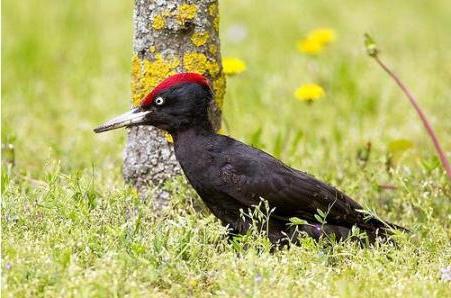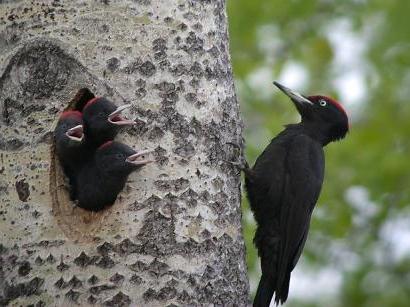Zhelna is a bird of the woodpecker family, a black woodpecker. This is one of the largest representatives of its kind. The bird has a coal-black color, and if it weren’t for the top of the head for males and the nape for females, it would be rather difficult to distinguish it from the crow. The black woodpecker has one characteristic habit - he likes to accompany a person walking along its territory for some time. At the same time, he flies forward and observes, peering out from behind a tree. In olden times, superstitious people thought that it was they who were pursued by an evil spirit, and they killed a curious bird.

The black woodpecker (photo of the bird can be seen in the article) mainly leads a solitary life. The exception is the mating season, which begins when snow lies in the forest. Since the beginning of March, males have been trying to attract the attention of females, they shout loudly and knock on trees. Throughout the forest, at a great distance, a guttural "free-free-free-free" can be heard, which can turn into a meowing mournful cry - "keee."
After mating, the female and the male begin to settle in more remote areas of the forest. To build a nest, they hollow out a hollow in a tree. Basically, the male works on new housing, while half of him is watching him from neighboring branches. A nest is being built on smooth-bore tall trees. Most often, a black woodpecker chooses spruce, pine or aspen for this. The hollow is hollowed out at a height of at least 4 meters, it has an inlet of about 10x17 cm and a depth of 40 to 60 cm. It can take up to 4 weeks to build it. The same bird nest is used in subsequent years, however, if it is not occupied by other residents.

The bottom of the nest is lined with nothing but the bark of trees. In late April, the female lays from 4 to 5 eggs, and after two weeks of incubation, the chicks begin to hatch. In the nest, they spend the first 4 weeks of their life. At this time, their parents are engaged in their provision. They continue to do this for some time, when the chicks are already flying out of the nest.
In August, young birds completely leave not only the nest, but also the territory of their parents. They are looking for new places or those that were left without a host. As soon as the chicks fly away, adult birds begin to avoid each other. They sleep in a hollow, but everyone has their own "bedroom". And if you take into account that the black woodpecker considers a territory of several square kilometers to be its territory, then they do not have disputes over food.
The basis of the yellow diet is insects and their larvae. The black woodpecker destroys bark beetles, lumberjack beetles, goldfish, ants, horntail larvae and so on. In one day, he can eat up to 600 larvae, which is of great benefit to plants affected by insects. It often happens that a bird completely knocks down the bark from a tree or, extracting something especially tasty, makes rectangular holes in the trunk.
The black woodpecker is a settled bird; in winter it does not fly away from its "home" and feels there as well as in summer. For living, it most often prefers dense coniferous forests, but is also found in deciduous. Zhelna is distributed throughout the forest strip of Russia; it is found in Siberia, Kazakhstan, the Caucasus, and all the forests of the European part of our country. The black woodpecker is a permanent friend of trees, it must be protected, and today it is under the protection of our state.